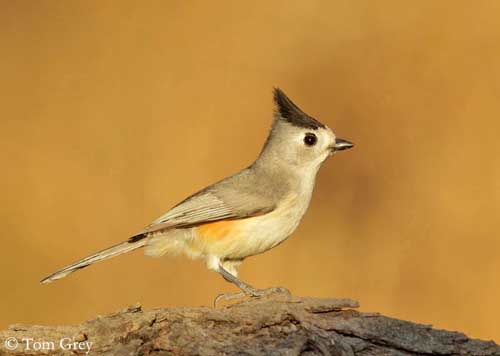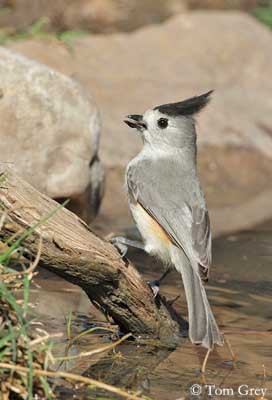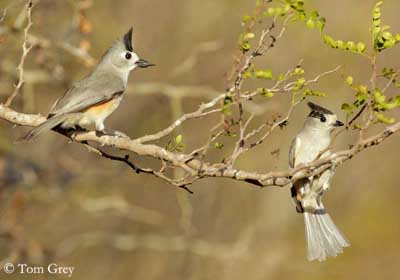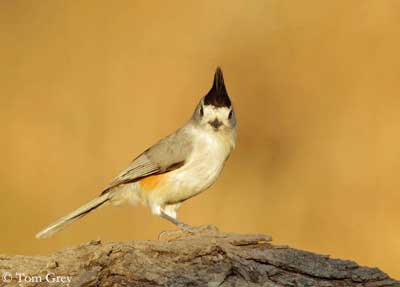
DIET:
The Black-crested Titmouse feeds primarily on small invertebrates and larvae such as insects and spiders. It also consumes some fruits, berries and seeds. During winter, nuts, pecan nuts and acorns are also taken.
PROTECTION / THREATS / STATUTS:
The Black-crested Titmouse is usually common in its range, except in the southern parts of the range in Mexico.
The species is not currently threatened.
Fr: Mésange à plummet noir
All : Schwarzhäubchenmeise
Esp: Herrerillo Crestinegro
Ital: Cincia dalla cresta nera
Sd: Svartkronad gråmes
Photographer:
Tom Grey
Tom Grey's Bird Pictures
Text by Nicole Bouglouan
Sources:
HANDBOOK OF THE BIRDS OF THE WORLD Vol 12 by Josep del Hoyo-Andrew Elliott-David Christie - Lynx Edicions - ISBN: 8496553423
A GUIDE TO THE BIRDS OF MEXICO AND NORTHERN CENTRAL AMERICA by Steve N. G. Howell, Sophie Webb - Oxford University Press - ISBN: 0198540124
The Birds of North America online
BirdLife International (BirdLife International)
What Bird-The ultimate Bird Guide (Mitchell Waite)
Black-crested Titmouse
Baeolophus atricristatus
Passeriforme Order – Paridae Family
BIOMETRICS:
Length: 14-15 cm
Wingspan: 27 cm
Weight: 15, 5 - 21 g
DESCRIPTION:
Closely related to the Tufted Titmouse, the Black-crested Titmouse has almost similar behaviour, but differs in head pattern. This bird is a medium-sized to large tit.
The adult male has grey, slightly tinged olive upperparts and upperwing-coverts. The rump is olive-brown. The tail is darker, brownish-grey, with outer rectrices broadly edged olive-grey. The flight feathers are brownish-grey, finely edged pale grey except the outer primaries.
The underparts are whitish, but the upper breast is washed pale grey. Flanks are orange-buff to cinnamon and the undertail-coverts are tinged buffish.
On the head, we can see a conspicuous black, pointed crest on the black crown. The forehead is whitish as lores and eye’s area. Cheeks, ear-coverts and neck sides are whitish-grey. Chin and throat are whitish.
The bill is black. The eyes are dark brown. Legs and feet are pale bluish-grey.

In worn plumage, the upperparts are paler grey, underparts are duller and flanks are paler.
The female is very similar, with duller and paler crown and crest. The crest is usually shorter than in male.
The juvenile has greyish-white forehead, greyer crown and shorter crest, browner upperparts and washed dull buff underparts.
We can find three subspecies:
B.a.atricristatus is found in S Texas and NE Mexico.
B.a. paloduro occurs in N and SW Texas, SW Oklahoma, S to N Mexico.
B.a. sennetti is found in C and S Texas.

VOICE: SOUNDS BY XENO-CANTO
The Black-crested Titmouse utters various calls such as a thin and explosive “tsit” as contact call, or thin “see-see-see” or “sit-sit-sit” as alarm call.
We can also hear typical “peew peew peew peew” and some variants, and also a sharper “cher-cher-cher-cher-cher-cher-vet-vet-vet”. These calls are fairly hard and nasal, and often doubled. Some buzzier “ssi-cheh ssi-cheh” are also given.
The song is a plaintive, repeated, ringing “chew chew chew chew” whistle sometimes uttered en long series, or a more slurred “p-lu p-lu p-lu” with higher second note.
Each male may have a repertoire of about 12 different songs.
HABITAT:
The Black-crested Titmouse occurs mainly in dry forest, especially mesquite (Proposis pubescens) and scrub, including the riparian woodland.
In Mexico, this species frequents the edges of evergreen forests, but also mixed Pinus-Quercus woodlands and forest in drier areas.
It can be seen between 150 and 2285 metres of elevation according to the range.
RANGE:
See above in “subspecies”.
BEHAVIOUR:
The Black-crested Titmouse feeds primarily on small invertebrates and larvae such as insects and spiders, and also takes berries and some fruits and seeds. Outside the nesting period, it feeds on nuts (pecan nuts) and acorns.
They form family groups of 6-8 birds after the nesting season and during winter.
During the breeding season, it is usually seen alone or in pairs.
The Black-crested Titmouse is very active and forages in trees, at all levels. But during the winter, this bird often occurs in the canopy. It searches for food in undergrowth and on the ground, but also among branches and foliage.

In late winter, the flocks break-up with increasing frequency of aggressive interactions between males, while they try to establish the territories. The pairs form at this period too.
The male performs courtship feeding to the female. It also adopts several postures in order to display the crest and the orange flanks. We can see head-up displays and exaggerated movements. They are cavity-nesters as all members of the family Paridae.
They are resident in their range, only performing short-distance flights and altitudinal movements.
FLIGHT:
The Black-crested Titmouse performs short, weak fluttering flights with rapid wing-beats. It also has undulating flight, alternating several rapid wing-beats with wings drawn to sides.
REPRODUCTION:
The breeding season occurs between late February and early June.
The Black-crested Titmouse is a cavity-nester. The nest is usually placed in hole or cavity up to 7 metres above the ground, in living tree or old stump. Abandoned holes by woodpeckers are often used, and also nest-boxes. The hole can be reused in successive years. The nest-site is at forest edge or in grassland with scattered trees.
The female builds the nest within the hole, mainly with moss, grass, lichens, leaves, bark strips, feathers and animal hair.
She lays 6-7 white or pinkish-white eggs and incubates alone during 13-14 days.
The Black-crested Titmouse is monogamous and solitary nester.
